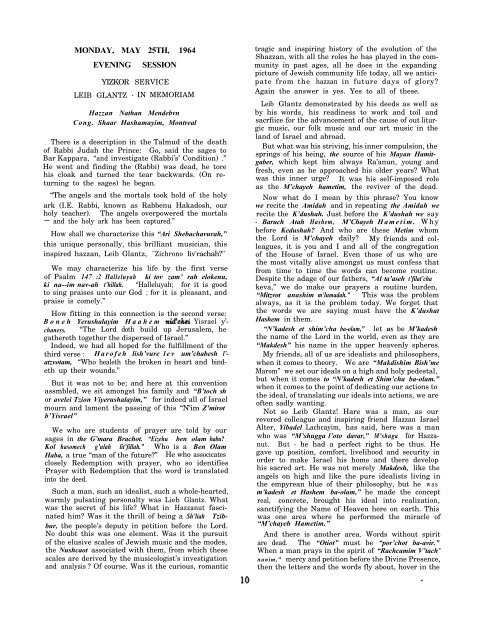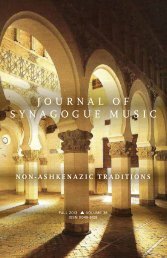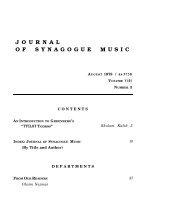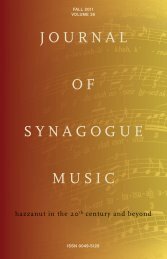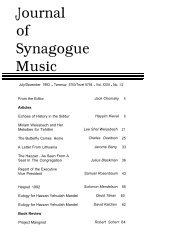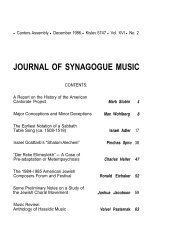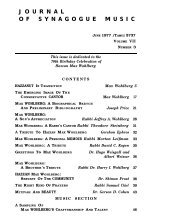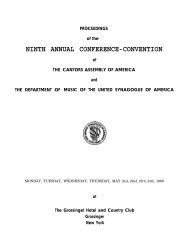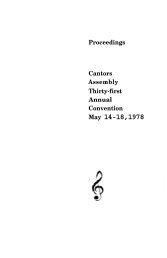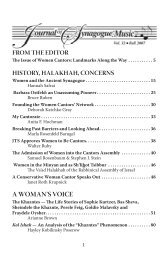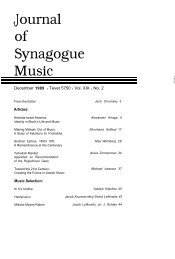1964 Proceedings - Cantors Assembly
1964 Proceedings - Cantors Assembly
1964 Proceedings - Cantors Assembly
You also want an ePaper? Increase the reach of your titles
YUMPU automatically turns print PDFs into web optimized ePapers that Google loves.
MONDAY, MAY 25TH, <strong>1964</strong><br />
EVENING SESSION<br />
YIZKOR SERVICE<br />
LEIB GLANTZ - IN MEMORIAM<br />
Hazzan Nathan Mendebvn<br />
Cong. Shaar Hashamayim, Montreal<br />
There is a description in the Talmud of the death<br />
of Rabbi Judah the Prince: Go, said the sages to<br />
Bar Kappara, “and investigate (Rabbi’s’ Condition) .”<br />
He went and finding the (Rabbi) was dead, he tore<br />
his cloak and turned the tear backwards. (On returning<br />
to the sages) he began.<br />
“The angels and the mortals took hold of the holy<br />
ark (I.E. Rabbi, known as Rabbenu Hakadosh, our<br />
holy teacher). The angels overpowered the mortals<br />
- and the holy ark has been captured.”<br />
How shall we characterize this “Ari Shebachavurah,”<br />
this unique personally, this brilliant musician, this<br />
inspired hazzan, Leib Glantz, "Zichrono liv'rachah?"<br />
We may characterize his life by the first verse<br />
of Psalm 147 :2 Halleluyah ki tov zam’ rah elokenu,<br />
ki na--im nav-ah t’hillah. “Halleluyah; for it is good<br />
to sing praises unto our God ; for it is pleasant, and<br />
praise is comely.”<br />
How fitting in this connection is the second verse:<br />
Boneh Yerushalayim Haahem nid'chei Yisrael y’chaness.<br />
“The Lord doth build up Jerusalem, he<br />
gathereth together the dispersed of Israel.”<br />
Indeed, we had all hoped for the fulfillment of the<br />
third verse : Harofeh lish’vure lev um’chabesh l’atzvotam,<br />
“Who healeth the broken in heart and bindeth<br />
up their wounds.”<br />
But it was not to be; and here at this convention<br />
assmbled, we sit amongst his family and “B’toch sh<br />
or avelei Tzion Viyerushalayim,” for indeed all of Israel<br />
mourn and lament the passing of this “N’im Z’mirot<br />
b’Yisrael”<br />
We who are students of prayer are told by our<br />
sages in the G’mara Brachot. “Eizehu ben olam habu?<br />
Kol hasomech g’ulah lit’fillah.” Who is a Ben Olam<br />
Haba, a true “man of the future?” He who associcates<br />
closely Redemption with prayer, who so identifies<br />
Prayer with Redemption that the word is translated<br />
into the deed.<br />
Such a man, such an idealist, such a whole-hearted,<br />
warmly pulsating personalty was Lieb Glantz. What<br />
was the secret of his life? What in Hazzanut fascinated<br />
him? Was it the thrill of being a Sh’liah Tzibbur,<br />
the people’s deputy in petition before the Lord.<br />
No doubt this was one element. Was it the pursuit<br />
of the elusive scales of Jewish music and the modes,<br />
the Nushcaot associated with them, from which these<br />
scales are derived by the musicologist’s investigation<br />
and analysis ? Of course. Was it the curious, romantic<br />
tragic and inspiring history of the evolution of the<br />
Shazzan, with all the roles he has played in the community<br />
in past ages, all he does in the expanding<br />
picture of Jewish community life today, all we anticipate<br />
from the hazzan in future days of glory?<br />
Again the answer is yes. Yes to all of these.<br />
Leib Glantz demonstrated by his deeds as well as<br />
by his words, his readiness to work and toil and<br />
sacrfiice for the advancement of the cause of out liturgic<br />
music, our folk music and our art music in the<br />
land of Israel and abroad.<br />
But what was his striving, his inner compulsion, the<br />
springs of his being, the source of his Mayan Hamitgaber,<br />
which kept him always Ra’anun, young and<br />
fresh, even as he approached his older years? What<br />
was this inner urge? It was his self-imposed role<br />
as the M’chayeh hametim, the reviver of the dead.<br />
Now what do I mean by this phrase? You know<br />
we recite the Amidah and in repeating the Amidah we<br />
recite the K’dushah. Just before the K’dushah we say<br />
- Baruch Atah Hashem, M’Chayeh Hametim. Why<br />
before Kedushah? And who are these Metim whom<br />
the Lord is M’chayeh daily? My friends and colleagues,<br />
it is you and I and all of the congregation<br />
of the House of Israel. Even those of us who are<br />
the most vitally alive amongst us must confess that<br />
from time to time the words can become routine.<br />
Despite the adage of our fathers, “Al ta’aseh t’filat’cha<br />
keva,” we do make our prayers a routine burden,<br />
“Mitzvot anashim m’lumadah.” This was the problem<br />
always, as it is the problem today. We forget that<br />
the words we are saying must have the K’dushat<br />
Hashem in them.<br />
“N’kadesh et shim’cha ba-olam,” let us be M’kadesh<br />
the name of the Lord in the world, even as they are<br />
“Makdesh” his name in the upper heavenly spheres.<br />
My friends, all of us are idealists and philosophers,<br />
when it comes to theory. We are “Makdishim Bish’me<br />
Marom” we set our ideals on a high and holy pedestal,<br />
but when it comes to “N’kadesh et Shim’cha ba-olam.”<br />
when it comes to the point of dedicating our actions to<br />
the ideal, of translating our ideals into actions, we are<br />
often sadly wanting.<br />
Not so Leib Glantz! Hare was a man, as our<br />
revered colleague and inspiring friend Hazzan Israel<br />
Alter, Yibadel Lachcayim, has said, here was a man<br />
who was “M’shugga l’oto davar,” M’shuga for Hazzanut.<br />
But - he had a perfect right to be thus. He<br />
gave up position, comfort, livelihood and security in<br />
order to make Israel his home and there develop<br />
his sacred art. He was not merely Makdesh, like the<br />
angels on high and like the pure idealists living in<br />
the empyrean blue of their philosophy, but he was<br />
m’kadesh et Hashem ba-olam,” he made the concept<br />
real, concrete, brought his ideal into realization,<br />
sanctifying the Name of Heaven here on earth. This<br />
was one area where he performed the miracle of<br />
“M’chayeh Hametim.”<br />
And there is another area. Words without spirit<br />
are dead. The “Otiot” must be “por’chot ba-avir.”<br />
When a man prays in the spirit of “Rachcamim V’tach’<br />
nunim," mercy and petition before the Divine Presence,<br />
then the letters and the words fly about, hover in the


